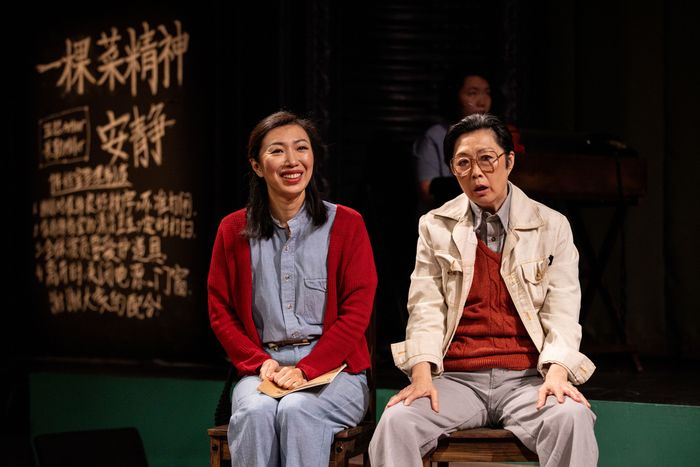
The ÔÇ£Hey, did you know this really interesting thing once happened in history?ÔÇØ play can be delicate to pull off. The appeal is obvious (wow, that is interesting!), while the pitfalls can sometimes be buried under a proliferation of cool facts. Chiefly, these plays run the risk of being all events and no Event ÔÇö living Wikipedia pages without a motivating, animating struggle.
Right now, in the East Village and in Williamsburg, two new Interesting Excerpt From History plays are taking a different approach to this tricky terrain. Rather than leaping across the plot-versus-drama trap, Jeremy TiangÔÇÖs Salesmanõ╣ﵡ╗ (at the Connelly Theater) and the collaboratively authored, effusively titled Room, Room, Room, in the many Mansions of eternal glory for Thee and for everyone (at the Brick) have chosen to navigate around it. Neither is intensely dramatic, but both are theatrical. They make the most of their spaces, their ensembles, the exposed tools of their stagecraft, and their connection with the audience to build productions that feel edifying, and more importantly, meaningfully communal.
Salesmanõ╣ﵡ╗ began with its director, Michael Leibenluft, who discovered Arthur MillerÔÇÖs memoir Salesman in Beijing while in college. The book is the playwrightÔÇÖs story of his 1983 trip to China, where he was invited during the post-Mao cultural thaw to direct an all-Chinese cast in a production of Death of a Salesman at the Beijing PeopleÔÇÖs Art Theater. (The Mandarin characters in this SalesmanÔÇÖs title, pronounced ÔÇ£zhisi,ÔÇØ mean ÔÇ£death of.ÔÇØ) Years later, after spending time directing in Shanghai, Leibenluft began looking for collaborators to help turn MillerÔÇÖs memoir into a play. Tiang signed on to write the script in 2017.
The resulting production is layered and engaging ÔÇö itÔÇÖs a memory play, a play about making a play, a true story, and a story of cultural contrast, confusion, and collaboration. ItÔÇÖs also fully bilingual ÔÇö English and Mandarin surtitles are nimbly deployed throughout by a droll onstage operator, Xingying Peng, who also provides neat, simple transition-marking percussion ÔÇö and itÔÇÖs cast with six women, five who are immigrants from Taiwan and China and one who is Korean American. Leibenluft describes the showÔÇÖs casting as a way to ÔÇ£[highlight] the women who are part of this history and who are often overlooked,ÔÇØ which is nice, if a little pat. However, thereÔÇÖs another, more theatrically compelling way to think about the ensemble, and thatÔÇÖs through the lens of the playÔÇÖs shifted center ÔÇö not Arthur Miller but the real-life interpreter who was hired to work with him, then a young professor of American literature at Peking University, Shen Huihui (played by Jo Mei).
Shen is our narrator, and like Tom Wingfield before her, she teaches us the rules: ÔÇ£Do note that tonightÔÇÖs performance contains multiculturalism, meta-theatrical elements, and Communist ideas,ÔÇØ she informs us at the top of the show. The real Shen Huihui is credited as ÔÇ£Story ConsultantÔÇØ on the production, and itÔÇÖs her perspective (or that of her onstage avatar) that shapes the play. These are her memories, and the women embodying them in part read as versions of her ÔÇö a theater company of Shens, playing out this transformative chapter of her life.
That company is a fun one, especially when taking on the characters who populate the PeopleÔÇÖs Art Theater (or ÔÇ£RenyiÔÇØ ÔÇö ÔÇ£ÔÇÖRenÔÇÖ is people, ÔÇÖyiÔÇÖ is art,ÔÇØ Shen explains to Arthur). As Li Shilong and Mi Tiezeng, the two young men playing Biff and Happy in RenyiÔÇÖs production, Julia Gu and Claire Hsu exude a wonderful combination of masculine seriousness about their craft, alternating confidence and confusion over American culture, and man-boy-ish mischief. (When they think no one is looking, Li tries to sell Mi one of the ÔÇ£interesting magazinesÔÇØ he found while on tour in Hong Kong: ÔÇ£the sort you canÔÇÖt get in China.ÔÇØ) Gu is also delightful as Designer Huang, RenyiÔÇÖs master of mise-en-sc├¿ne. Stooped and shuffling, but sharp as upholstery tacks and apparently immortal, Huang takes glorious umbrage at any questioning of his craft ÔÇö but heÔÇÖs also ready to be appropriately appeased. When Arthur MillerÔÇÖs wife, the Austrian photographer Inge Morath (Lydia Jialu Li, who also gives a lucid, dignified performance as Ying Ruocheng, the Renyi actor playing Willy Loman), brings him some sweets as an apology for a tiff with her husband, Huang purses his lips and considers shrewdly: ÔÇ£The candy-covered bullets of capitalism. Okay, IÔÇÖll accept them.ÔÇØ
While some of SalesmanÔÇÖs scenes can feel a little rote ÔÇö crafted more around a historical nugget than an urgent investigation of theme or character ÔÇö the show wisely moves along quickly to the play-within-the-playÔÇÖs rehearsals. There, Sonnie BrownÔÇÖs dry, furrow-browed Arthur Miller can take the stage (BrownÔÇÖs flat American accent is just brusque and loud enough without becoming caricature), and plot can take a backseat to the productionÔÇÖs real interest: the often comic collision of cultures and the complexity of interpretation.
After the companyÔÇÖs first read-through, Miller ÔÇö as all the Renyi actors refer to him, with something between respect and wary curiosity ÔÇö is aghast at the playÔÇÖs length. ShenÔÇÖs interpretation of his distress: ÔÇ£Congratulations, everyone, you achieved a performance time of four hours!ÔÇØ Zhu Lin (Sandia Ang), the actress playing Linda Loman, is impressed rather than horrified. Even RenyiÔÇÖs revered artistic director, the great playwright Cao Yu (also Ang, in a brief, entertaining cameo), ÔÇ£doesnÔÇÖt write such long plays,ÔÇØ she marvels. ÔÇ£No wonder heÔÇÖs an American master.ÔÇØ Much of the delight of Salesmanõ╣ﵡ╗ comes from its wryly observed moments of getting, if not lost, then at least turned about in translation. This kind of joke can feel a little easy, but Tiang, Leibenluft, and their ensemble avoid┬áany sense of schtickiness through simplicity, sincerity, and focus. Everyone is here to do their job well ÔÇö to listen, to learn, and to make something excellent ÔÇö and if that requires a pause to figure out what exactly an insurance salesman is in the first place, so be it. ShenÔÇÖs explanation: ÔÇ£In America, they have this thing called ÔÇÿinsurance.ÔÇÖ People get money for dying.ÔÇØ ÔÇ£Ohhhh,ÔÇØ respond Li and Mi, ÔÇ£like revolutionary martyrs.ÔÇØ
Ultimately, Salesmanõ╣ﵡ╗ breaks open into a kind of multilayered memoir-meets-documentary. Cinthia ChenÔÇÖs projection designs show us footage from RenyiÔÇÖs actual 1983 production, flickering across the set as the actors perform along with it. The old footage feels semi-miraculous, as does Chika ShimizuÔÇÖs superb scenic design. ThereÔÇÖs a special thrill when a production manages to transfigure an old space like the Connelly, with its aura of gas lamps and ghost lights. ShimizuÔÇÖs set both acknowledges and expands upon this raw material; it plays with the architecture rather than simply in it. By extending the stage into a thrust and, behind the proscenium arch, creating layer after overlapping layer in the playing space using curtains, scrims, and elegant, rotatable scenery, Shimizu renders the playÔÇÖs palimpsest tangible. Every gesture is graceful, precise ÔÇö an aesthetic demonstration of exactly what Salesmanõ╣ﵡ╗ aims to dramatize: the nuanced, elucidating, and transformative act of translation.
_
Room, Room, Room, in the many Mansions of eternal glory for Thee and for everyone is part concert, part queer church service, part rave, and all big, tender, welcoming energy. The writer-performer-musicians Philip Santos Schaffer, syd island, and Andy Boyd ÔÇö here collectively calling themselves Friend of Friend ÔÇö are genuinely excited to bring you another historical fascination, this one known as the Publick Universal Friend. HereÔÇÖs the gist: On October 10, 1776, a 24-year-old Quaker woman named Jemima Wilkinson died. Or at least, thatÔÇÖs how the prophet that the Quaker-formerly-known-as-Jemima became would later explain it. In death, Jemima received a vision, and then a new person was born. This was, in the showÔÇÖs affectionate shorthand, PUF (like ÔÇ£puff,ÔÇØ no ÔÇ£theÔÇØ necessary among friends). For the next 43 years, until their (second?) death in 1819, the Friend led a community of spiritual followers, preaching a radical variation on Quaker theology that stressed free will, GodÔÇÖs love, the abolition of slavery, and the possibility of utopian community and universal salvation. The Friend also, as Schaffer tells us early on in Room, Room, Room, ÔÇ£refused to use gendered pronouns or respond to angry demands that the Friend declare Friendself to be either a man or a woman, saying simply, ÔÇÿI am that I am.ÔÇÖÔÇØ
In a mostly empty space, accompanied by an array of quirky Gen-Z-meets-Powerpoint projections; accompanying themselves on ukulele, banjo, and accordion; and dressed in an exuberant variety of pink-and-teal thrift store chic, Boyd, island, and Schaffer take us on a 90-minute tour of the FriendÔÇÖs life and work. Along the way, personal reflections on growing up ÔÇö on gender, God, shame, joy, and the inherent transness of hyperpop ÔÇö interweave with historical fact and original song (and, fair warning, a healthy helping of earnest audience participation).
Room, Room, Room often feels like a live performance of a folk-pop concept album, complete with dramatized liner notes ÔÇö and its real achievement is that many of the songs do indeed slap. Days later, IÔÇÖm still humming the title tune, wherein the FriendÔÇÖs sermon recounting their great pre-resurrection vision is set to music. Boyd, island, and Schaffer often draw their lyrics from the FriendÔÇÖs deep catalog of spiritual writings, and thereÔÇÖs something wistful and raw about hearing such solemn, ecstatic texts as delicate indie tunes. The showÔÇÖs creative trio might be thinking about SOPHIE and 100 Gecs; I kept thinking of Sufjan Stevens.
As singer-songwriters and as musicians, Friend of Friend shares a level of craft, sincerity, and whimsy that keeps the vessel theyÔÇÖve built buoyant, despite its intermittent tendency to steer towards well-meaning sanctimony. ItÔÇÖs a popular destination these days, and it can be difficult to figure out whether heading there is an honest, needful act of reparation, or a kind of impulsive, self-conscious flag-planting ÔÇö a shorthand for a set of values that could more effectively be shown rather than told.
Room, Room, Room shines brightest when it returns to such generous showing ÔÇö when island asks us, if weÔÇÖre okay with it, to ÔÇ£join hands, and join in with our voices in the refrain the angels spoke to PUF.ÔÇØ Or when Schaffer plays ÔÇ£Subway Song,ÔÇØ a lyrical gift to that stranger on the train who sees them, is seen by them, and for a moment helps to create a shared space of solidarity and safety. Or, especially, when Boyd sings gently of the certain apocalypse, then encourages us, in the face of it, to love each other harder.
Salesmanõ╣ﵡ╗ is at the Connelly Theater through October 28.
Room, Room, Room, in the many Mansions of eternal glory for Thee and for everyone is at the Brick through October 28.



